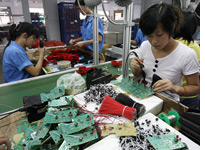
For years, American importers and Chinese factory managers have been having the same conversation. The importers would demand lower prices for products destined for American shelves. Factory managers would counter with a long list of reasons why they needed to charge more. Most of the time, the American importers would prevail, and Wal-Mart shoppers would rejoice.
Not anymore. The era of cheap Chinese consumer goods may finally be ending, thanks to irrepressible inflation. Now when the Chinese present their lists, some American importers are conceding higher prices, meaning that American shoppers, for the first time in years, are starting to pick up the tab for rising costs in China. Some Chinese factories are now asking their American customers for price increases of as much as 20 percent to 30 percent.
A store manager at a young women's clothing store in Boston tells me the prices of some camisoles are rising. An executive in the athletic shoe industry says that Chinese factories and buyers are now negotiating about spring 2009 shoe lines, and that is where consumers will really start to see the impact of Chinese inflation. A manager of several discount stores confides his company has started raising prices of certain goods while putting others on sale. This is only the beginning: We'll be paying higher prices for Chinese goods for years to come.
Consumers of Chinese exports (read: you and I) have for the past two decades benefited from an extraordinary confluence of factors. China's desire to attract foreign investment, rural workers' hunger for higher wages than they could earn on the farm, and excess capacity in nearly every industry helped limit price increases for Chinese exports. The renminbi was undervalued, wages were low, raw materials were cheap, and government officials turned a blind eye to factories' labor and environmental violations.
But now a perfect storm has hit China's manufacturers. So far this year, the renminbi has been appreciating at a 16 percent annualized rate. And prices for raw materials, which account for 60 percent to 70 percent of manufacturers' costs, are soaring. Hundred-dollar-a-barrel oil has raised transport costs and the price of oil-related materials such as plastics. Although some economists expect raw material prices to weaken in the second half of this year, in the long term, the emergence of millions of new car drivers, home buyers, and office workers in India and China will keep the price of steel, plastic, and other raw materials high.
At the same time, China is rolling out wage increases around the country and tightening its labor laws. Wages are rising at double-digit rates in coastal China. In January, Beijing introduced a new labor law that significantly strengthened the influence of the union in management decisions. The All-China Federation of Trade Unions, the country's state-backed labor organization, has launched an aggressive recruiting campaign. Beijing hopes that better protection for workers through the union and the new labor law will placate its increasingly restive manufacturing workforce. But a tidal shift in the country's demographics—a dwindling supply of young workers as a result of the "one child" policy in effect since 1979—will counteract Beijing's efforts.
China's Generation Y, the children born after the one-child policy came into effect, are increasingly aware of their rights to a legal wage, health insurance, and a certain number of days off every month. Their demands for better treatment will continue to drive up the cost of manufacturing in China. Already, southern China's Guangdong province, known as "the workshop of the world," is short 2 million workers, the equivalent of 14 percent of America's entire manufacturing workforce.
The problem for American retailers and consumers hooked on $3 T-shirts and $30 DVD players is that there is no other China waiting in the wings to make cheap goods reliably for American shoppers. American importers are now arriving by the planeload in Vietnam, hoping to take advantage of the country's lower wages. But Vietnam, hard as it tries, has only 85 million people—the size of one Chinese province. And only a fraction of its population is suitable for factory work. Moreover, prices are rising faster in Vietnam than anywhere else in Asia. Add in the rising incidence of strikes and labor disputes, and Vietnam looks increasingly like a short-term alternative.
India, the other country often mentioned as a China surrogate, has not yet managed to get its act together to take advantage of China's rising export prices. Importers say India is good at certain things—embroidery, for instance—but not at the volume production that the world depends on for cheap goods. India's road and port infrastructure, while improving, is nowhere near as efficient as China's.
So importers are looking back to countries they once rejected in favor of China—Indonesia, Mexico, and Malaysia. And they are looking ahead to countries not yet integrated into the global consumer-goods supply chain, such as Brazil and Kenya. Every country, however, offers its own special risks: strong labor unions in one, political instability in another. None offers the one-stop shop appeal of China, where factories make everything under the sun. For the time being, then, we will all still be buying a lot of "Made in China" products—and paying ever more for them.



No comments:
Post a Comment